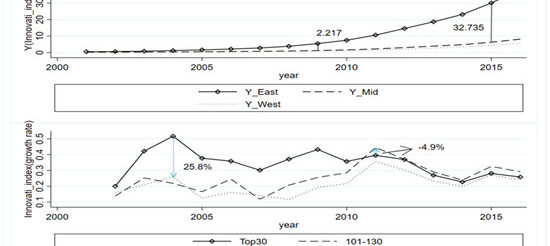IJERPH | Free Full-Text | Does Innovative City Pilot Policy Stimulate the Chinese Regional Innovation: An Application of DID Model

Feature Papers represent the most advanced research with significant potential for high impact in the field. Feature
Papers are submitted upon individual invitation or recommendation by the scientific editors and undergo peer review
prior to publication.
The Feature Paper can be either an original research article, a substantial novel research study that often involves
several techniques or approaches, or a comprehensive review paper with concise and precise updates on the latest
progress in the field that systematically reviews the most exciting advances in scientific literature. This type of
paper provides an outlook on future directions of research or possible applications.
The above analysis shows that even though the ICP has been piloted in cities of different tiers, the innovation gap between cities is still likely to widen further. Of course, expanding the pilot cities to inland non-first-tier cities is itself an attempt to narrow regional differences. Late-developing cities have more room for development [37] and can also accept technology and knowledge transferred from coastal areas [34,41,42]. Therefore, overall, the effect of ICP on innovation differences is uncertain.
The convergence effect of policy could be seen from different perspectives. Figure 2 illustrates the research framework. First, we examined whether pilot cities have a higher rate of innovation convergence than non-pilot cities (Convergence_1). Second, we considered the pilot policy’s spatial spillover effects (basic and convergence effect) because the spillover distance affects the number of cities within the radius of the innovation center. Additionally, the radii of influence of basic and impact of convergence may differ. However, some cities see an increase in the level of innovation due to the innovative city near them (innovation center); because the spillover effect is too small, it may not be enough to accelerate the convergence to developed regions (Convergence_2). Finally, we investigated potential regional heterogeneity in policy effects. Innovation differences between Chinese cities appear not only in regions but also in a trend toward further expansion of innovation differences in cities within regions. Therefore, we also examined whether the pilot policy’s basic and convergence effects are significant in different regions (Convergence_3).
The benchmark test and regression results of the moderating effect reflect the average impact of the pilot policy’s basic and convergence effects. Still, they do not reflect the difference in policy impact in different periods. Furthermore, the parallel trend assumption for the treatment and control groups should be satisfied when using the DID method. Therefore, we examined the dynamic effects of the pilot policy with the event study approach and constructed the following model:
Method (2): To verify the robustness of the results of method (1), we construct the following model:
We also verified the rationality of our choice of instrumental variables through a strict measurement inspection. First, we performed a regression with , as the explained variable and as the explanatory variable. The results in Table 5 indicate no significant association between the two (reports only as a regression of the dependent variable due to space limitations). Columns 22, 24, and 25 show the first-stage regression results. The coefficient of Slope × Year is negative, indicating an inverse relationship between a city’s average slope and whether it is an innovative city. The under-identification test (Kleibergen-Paap rk Wald F is 28.636 and 66.687, rejecting the null hypothesis) and weak instrumental variable test (all statistical values above the 15% maximal IV size) results also show that the selected instrumental variable does not indicate problems with insufficient and weak instrumental variables. From the second-stage regression, the coefficients of the lag term L.ln_Y are all significantly negative. The pilot policy coefficient in column 21 is −0.323 (significant at the 1% level), which is also consistent with Equation (3) results. The coefficients of in columns 2 and 3 are significantly negative, indicating that the underlying two-way causality does not significantly affect the innovation convergence effect of the policy.
To further overcome the influence of sample selection bias on the estimation results, we applied the propensity score matching (PSM) method to match the samples. We incorporated all the control variables in Equation (2) into Equation (8):
As economic development and innovation resource endowments differ between regions in China, innovation activities are unevenly distributed in space. We next checked whether this regional heterogeneity leads to differences in the impacts of innovative urban pilot policy. This pilot project is a new opportunity for underdeveloped regions in the west to catch up with the east, or it will further widen the differences in innovation levels between regions. To clarify this issue, we divided China into east, central, and west and constructed two comparative analysis groups: east–west (Group1) and east, central–west (Group2).
Based on the above results, our research conclusions are as follows. First, there is innovation convergence (absolute and conditional) among Chinese cities. Second, the innovative city policy not only improves the innovation level of pilot cities but also promotes innovation convergence among pilot cities (Convergence_1). Third, the policy helps to improve innovation levels in the pilot and surrounding cities and accelerate innovation convergence among these cities (Convergence_2). Compared to the basic effect, the convergence effect has a time lag. However, the radius of action of the latter is slightly smaller than that of the former. Finally, for Convergence_3, the policy promotes innovation development and convergence of the pilot cities in the central and eastern regions. Still, this effect is not significant in the western region.
Disclaimer/Publisher’s Note: The statements, opinions and data contained in all publications are solely those of the individual author(s) and contributor(s) and not of MDPI and/or the editor(s). MDPI and/or the editor(s) disclaim responsibility for any injury to people or property resulting from any ideas, methods, instructions or products referred to in the content.
